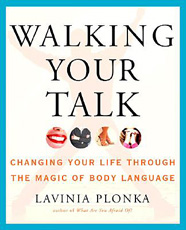An Emmy-nominated choreographer and a former artist-in-residence at the Guggenheim Museum in New York City, Lavinia Ploka is the author of What Are You Afraid Of? She teaches Feldenkrais and theater-based workshops and is the director of the Asheville Movement Center in North Carolina. In this accessible paperback she explores the basics of body language with special chapters devoted to legs, arms and hands, chest, pelvis, head, and face. The way we move and carry ourselves has an impact on our relationships, work, health, and happiness. The trouble is that most of us do not listen to our bodies and oftentimes get stuck in habitual gestures, postures, and ways of moving that are stress inducing.
The most interesting chapter is "Giving and Receiving — The Arms and Hands" where Plonka also covers the shoulders. Each joint in the body reveals aspects of the emotional life. The shoulders have been called the hiding out place of the emotions. She points out that the term "to shoulder responsibility" has been taken literally by many people who walk tensely with their shoulders raised. Plonka notes:
"The Startle Reflex is an instinct we are born with. When you lose your balance, are falling, or hear a loud sound, your entire body reacts and then moves to protect you from danger. If you've ever been working in a quiet room and suddenly you hear a loud door slam, the jump is the startle reflex in action. Part of the startle reflex involves a raising of the shoulders — both as a protective mechanism (protecting the viscera) as well as an auxiliary move to literally hold you up. This movement can become habitual from childhood ('Watch out Johnny, you'll fall!') and sometimes it just gets stuck that way. People locked in this startle reflex communicate a sense of tension and weakness simultaneously. And for good reason — when the shoulders are frozen and up, effective movement of the arms and torso is compromised, creating fertile ground for injury. Raised or rigid shoulders inhibit the ability of the head to turn and compromise effective breathing, leading to even greater tension."
Plonka presents movement exercises to deal with stress and tension points in the body. She also discusses self-sabotaging behaviors and ways to develop a kinesthetic sixth sense. The book ends with a chapter on embodying compassion.
